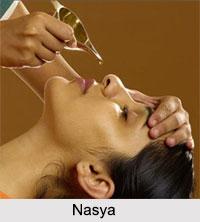 Nasya in Ayurveda purges and rejuvenates the tissues and specific organs of the head and neck region. It also introduces medicated oils and powders into the nose, which is the nearest access and passage to the organs of the head. It eliminates aama and toxins from the nose, mouth, ears, eyes and para-nasal sinuses. In Ayurveda, it is described that the nose is the main doorway to the brain. Nasya cleanses and opens the channels of the head and improves oxygenation, which is the flow of the prana. It has a direct and effectively beneficial influence on brain functioning.
Nasya in Ayurveda purges and rejuvenates the tissues and specific organs of the head and neck region. It also introduces medicated oils and powders into the nose, which is the nearest access and passage to the organs of the head. It eliminates aama and toxins from the nose, mouth, ears, eyes and para-nasal sinuses. In Ayurveda, it is described that the nose is the main doorway to the brain. Nasya cleanses and opens the channels of the head and improves oxygenation, which is the flow of the prana. It has a direct and effectively beneficial influence on brain functioning.
Types of Nasya
Nasya therapy is classified into various categories which are as follows:
1. Pradhamana Nasya: This therapy is mainly used to treat diseases caused by Kapha disorder like headaches, nasal congestion, cold, sticky eyes, heaviness in head and hoarseness of voice.
2. Bruhana Nasya: This therapy is effectively cure diseases caused due to Vata disorder such as migraine, dry nose, anxiety, dryness of voice, dizziness, etc.
3. Shaman Nasya: This therapy is used according to dosha that is aggravated most in human body. Basically it used to treat pitta disorder.
4. Navana Nasya: It is used in curing Kapha-pitta or vata-pitta disorder.
5. Marshy Nasya: This therapy is used to treat uneasiness arise due to occurring of some disease.
6. Pratimarshya: This therapy helps in reducing stress and it works greatly.
Procedure of Nasya
The procedure of Nasya is done in the following three steps;
•In the Poorvakarma, it includes facial oil massage or application of steam to face, forehead, head, ears and neck. This helps to loosen the adhesive doshas.
•The Pradhanakarma includes instillation of luke warm medication in both the nostrils, alternately, with the help of proper instrument like dropper. The sole, shoulder, neck, ear and palm are gently massaged after the administration of the drug.
•In Paschatkarma, the patient"s mouth is cleaned by giving luke warm water to gargle and then medicated smoke is given for inhalation.
Benefits of Nasya
Nasya treatment in Ayurveda effectively eliminates heaviness in the head, headaches, swollen lymph glands and nasal congestion. Nasya is used for dry nasal passages as well as common cold, sinus congestion, allergies, allergic rhinitis and chronic sinusitis. It also eases chronic vascular headaches, epilepsy, migraine and it has a positive effect on degenerative diseases of mental retardation and of the brain. Nasya helps in healing problems associated with ear and eye such as itching and watery eyes, hearing loss and tinnitus, glaucoma, conjunctivitis as well as loss of sense of smell.
Cautions about Nasya
Nasya therapy is not administered for dehydrated infants or for those who are experiencing severe anger or panic. It should not be administered immediately after bathing. Ayurvedic physicians advises some precautionary measures when the treatment is given to pregnant women. Apart from these cases, any individual aged from 8 to 80 can be treated by nasya therapy.





